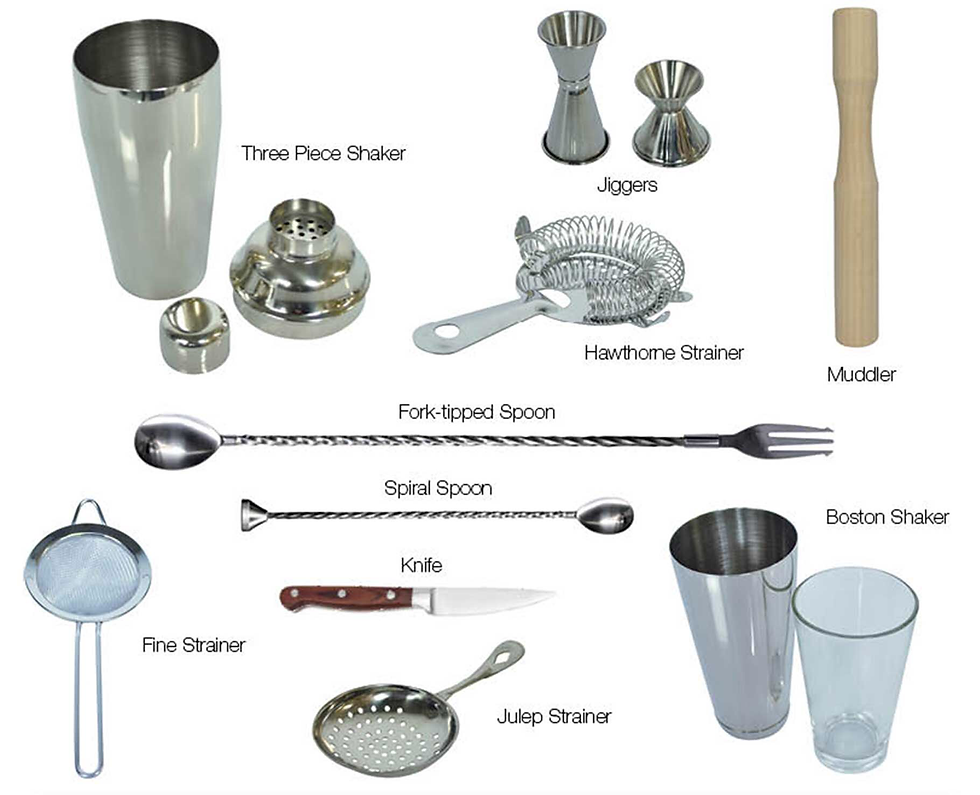Mixology Equipment
Most common equipment and tools used by bartenders:
Tools
Glasses
Bar spoons
Stirring is one way to mix a cocktail, such as a gin or whiskey cocktail, gently mixing the distilled spirit to maintain a balance of flavor.
For this bar spoons are essential, with their long-twisted handles that make it easy to stir in a smooth circular motion. Bar spoons gently stir the ingredients to just the right dilution without breaking down the ice. They also help bartenders to layer drinks, pouring a second liquor or mix down along the stem of the bar spoon to create a layered drink that’s visually appealing.
Bottle opener
One tool that no bar can do without is a bottle opener. For beer on tap, you won’t need a bottle opener, but you will for any bottled beer or other capped beverages. Consider using openers that are wall-mounted – they’re fast to use and won’t be misplaced behind the bar.
Corkscrew
Invest in professional corkscrews that slide effortlessly into the cork and extract easily without crumbling or damaging the cork. Choose one that’s stainless steel with an easy-to-hold handle.
Cocktail shaker
A well-equipped bar has one or more cocktail shakers to provide customers with the ideal shaken beverage. Ingredients are placed in the sealed stainless-steel shaker, typically liquor, syrups, fruit juices, and ice. After vigorously shaking and mixing the drink, shakers allow for easy pouring into the customer glass. Many varieties of shakers come with built-in strainers to separate the ice or other ingredients.
Cocktail strainer
If your cocktail shaker doesn’t come with a built-in strainer, you’ll want a cocktail strainer. You’ll need one of these to create cold ice-free drinks. The strainer is placed over the mouth of the shaker, with the small holes letting the drink pass through, leaving the ice in the shaker.
A common brand used by many bartenders is the Hawthorne strainer, which is made from stainless steel, is dishwasher safe, and fits most professional bar shakers.
Jigger
To be sure your bartenders are measuring correctly and consistently, not just for taste but so they’re not over-pouring, your bar tool inventory needs to include a jigger. Choose jiggers of different sizes, from .5oz to 2oz.
Muddler
It’s not just the Mojito that requires a muddler, this bartender’s tool is used to create many other cocktails. A good muddler will bring out the aromatics of herbs, spices, and fruits so that their flavors are released and infused into the drink.
Look for muddlers that are long-handled and ergonomically designed for easy holding. The long handle keeps bartenders from hitting their hands on the sides of the glass or cocktail shaker, allowing them to mix drinks safely and efficiently. Muddlers should also be durable and dishwasher safe.
Peeler
Featuring a sharp and stainless steel blade, this tool is designed to remove fruit skins.
Rimmer
If you’re making margaritas and other drinks that require a rimmed glass edge, a rimmer lets bartenders quickly create the perfect rim of salt or sugar. Choose one with multi trays, adding that burst of flavor to cocktails.
Zester
Although not the most-used tool behind the bar, some drinks such as a Dry Martini or a Cosmopolitan need a dusting of lemon or lime on top. A quick twist with a zester is all it takes for your bartenders to add that visual appeal and boost of flavor to drinks.
Highball
A tall glass that can store 8-12 oz. of liquid and measures about 7 cm x 15 cm. It is used to serve mixed drinks like tequila sunrise and long island iced tea.
Collins
Similar to the highball only taller and slimmer at 6 cm x 17 cm and can contain 10-14 oz. of liquid. It is also used for mixed drinks such as the Tom collins.
Rocks
A short glass with various designs that can contain 6-10 oz. of liquid and measures 3.5 in. in height and about 3 in. in diameter. It is also called old-fashioned glass or lowball glass and is typically used to serve whiskey or scotch with ice.
Coupe
It looks like a stemmed small bowl that is used to serve cocktails like aviation or daiquiris, though initially they were used for champagne.
Martini
Take the coupe glass but replace the round bowl shape with a triangular bowl. This is a typical glass for martinis as can be seen by the name. It is ideal if it is served with an olive on a toothpick.
Margarita
A variation of the coupe glass that has two curves and used to serve margaritas and even shrimp cocktails.
Flute
A fancy-looking glass that is slim and is used for champagne and mimosas. It can hold 6-10 oz. of liquid and its stem allows the drinker to hold it without affecting the drink’s temperature.
Shot glass
A tiny glass designed to allow the drinker to consume the drink in one gulp, called the “shot”. It can hold 25-50 ml of liquid and has several varieties like the shooter. It can also double as a jigger.




